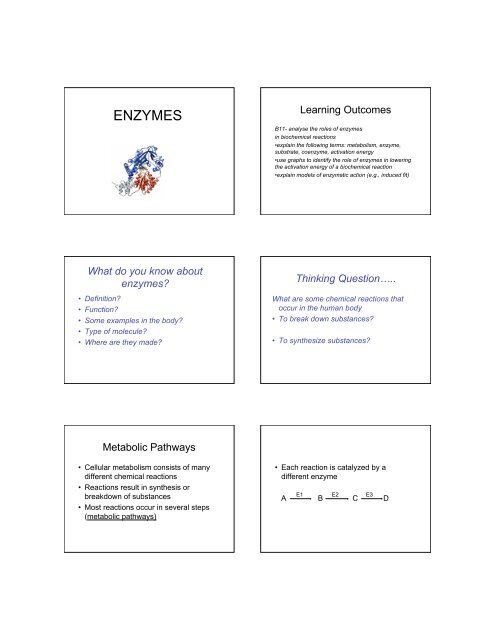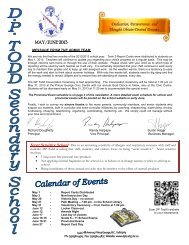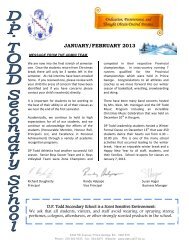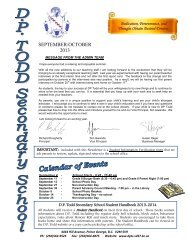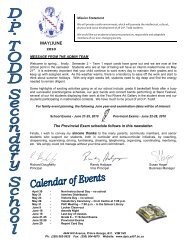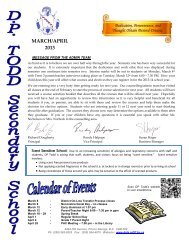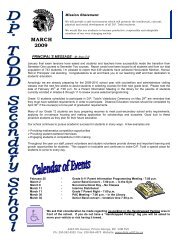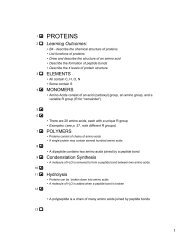enzymes 1.ppt.pdf
enzymes 1.ppt.pdf
enzymes 1.ppt.pdf
Create successful ePaper yourself
Turn your PDF publications into a flip-book with our unique Google optimized e-Paper software.
ENZYMES<br />
Learning Outcomes<br />
B11- analyse the roles of <strong>enzymes</strong><br />
in biochemical reactions<br />
•explain the following terms: metabolism, enzyme,<br />
substrate, coenzyme, activation energy<br />
•use graphs to identify the role of <strong>enzymes</strong> in lowering<br />
the activation energy of a biochemical reaction<br />
•explain models of enzymatic action (e.g., induced fit)<br />
What do you know about<br />
<strong>enzymes</strong><br />
• Definition<br />
• Function<br />
• Some examples in the body<br />
• Type of molecule<br />
• Where are they made<br />
Thinking Question…..<br />
What are some chemical reactions that<br />
occur in the human body<br />
• To break down substances<br />
• To synthesize substances<br />
Metabolic Pathways<br />
• Cellular metabolism consists of many<br />
different chemical reactions<br />
• Reactions result in synthesis or<br />
breakdown of substances<br />
• Most reactions occur in several steps<br />
(metabolic pathways)<br />
• Each reaction is catalyzed by a<br />
different enzyme<br />
E1 E2 E3<br />
A B C D
ENZYMES<br />
• Are usually proteins<br />
• Each have a specific shape<br />
• Are specific for one reaction<br />
• Act as organic catalysts<br />
• Are not used up in the reaction<br />
SUBSTRATES<br />
• Are the reactants in enzyme-catalyzed<br />
reactions<br />
• May be broken down (ex. hydrolysis),<br />
or combine with other substrates<br />
(synthesis)<br />
• Are used up in the reaction to produce<br />
products<br />
What are some examples of<br />
substrates…<br />
• Of digestive <strong>enzymes</strong><br />
• Of the enzyme DNA polymerase<br />
• Of <strong>enzymes</strong> in the mitochondria<br />
• Of hydrolytic <strong>enzymes</strong> in the<br />
lysosomes<br />
Examples of <strong>enzymes</strong><br />
• Polymerases - catalyze polymerization<br />
reactions<br />
• Catalase - breaks down hydrogen<br />
peroxide (H 2 O 2 )<br />
• Digestive <strong>enzymes</strong> - amylase, lipase,<br />
lactase, etc.<br />
(names usually end in “ase”)<br />
Enzyme activity<br />
Fig. 6.5<br />
• All chemical reactions have a specific<br />
energy of activation, needed to get the<br />
reaction started<br />
• Enzymes lower the energy of activation<br />
of a chemical reaction, allowing the<br />
reaction to take place with a lower input<br />
of energy (at body temperature)
• Enzymes are specific for a particular<br />
substrate due to their shape<br />
Lock and key model<br />
• The active site of an enzyme binds to<br />
the substrate like a lock-and-key<br />
• An enzyme - substrate complex is<br />
formed<br />
Induced fit model<br />
Fig. 6.7<br />
• Sometimes the active site of an<br />
enzyme may change shape to fit the<br />
substrate<br />
TA p113<br />
• The reaction occurs while the substrate<br />
is attached to the enzyme<br />
• After the reaction is complete, the<br />
products are released<br />
• The enzyme is now free to combine<br />
with another molecule of substrate
Fig. 6.6


